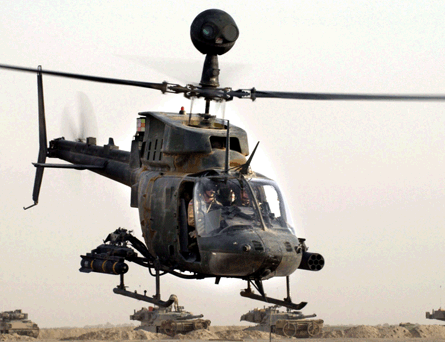No single aircraft is busier in Iraq and Afghanistan than the US Army's workhorse scout helicopter - the OH-58D Kiowa Warrior. The aircraft was designed to fly 14h a month. The deployed fleet averages 80-90h, flying as many as four patrols a day.
That's not bad for an aircraft that has permanently worn the "interim" label throughout its service life. It was christened in 1984 as an economical stop-gap until the RAH-66 Comanche would enter service. Twenty years later, the Kiowa Warrior was still the interim helicopter when the Comanche was finally cancelled.
It remained interim as Bell Helicopter launched - and ultimately lost - the opportunity to replace it with the ARH-70 Arapaho, foregoing necessary sensor and cockpit upgrades to fund a new helicopter with greater speed and payload capacity.
 |
|---|
© Rex FeaturesDon't shoot, we're only an interim measure |
The army continues to consider options for finally retiring the OH-58D. An analysis of alternatives to define options for launching an armed aerial scout will be complete in April. The global helicopter industry has lined up a wide range of candidates.
But the signs are growing that the army will finally lift the interim stamp on the OH-58D. In recent weeks, army aviation and industry officials have discussed options for skipping over the AAS replacement programme and start early development of a new joint multi-role family of rotorcraft.
Meanwhile, the army has publicised its commitment to fund a series of long-delayed upgrades for the OH-58 fleet. The rebranded OH-58F will carry a modern, nose-mounted sensor and a new cockpit system.
The track record for the US army aviation community does not inspire confidence. Billions of dollars have been spent to acquire a permanent scout helicopter fleet since 1984, yet the Kiowa Warrior lingers on.
Buying an off-the-shelf helicopter that is far more capable than the OH-58D is an option today. The cruise speed of the OH-58D ranges from 90-100kt (165-185km/h), so unless Bell can integrate a far more powerful engine, it is unlikely to achieve the army's new standard for hovering ability at high altitudes in hot weather.
The joint multi-role family could lead to the next breakthroughs in rotorcraft technology, or take a place on the list of promising helicopter development projects doomed by lack of funding and/or poor execution.
Gambling on another new development programme is a risky choice. For the busiest aircraft in combat today, the army needs something it can count on.
Source: Flight International






















